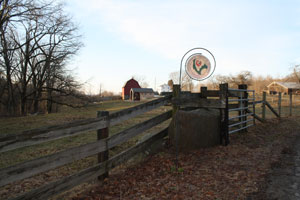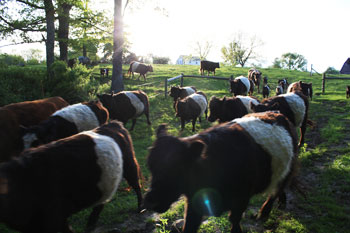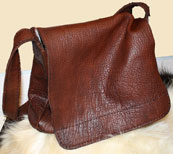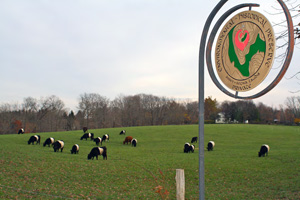
 |
|
|


St Lucy’s farm, off of Robert Leather Road, is the home of the Abbey’s Belted Galloway beef herd. Our herd is grass fed, with access to over 25 acres of pasture grass. They receive no hormones or antibiotics. Originally a beef Shorthorn and mixed-breed herd, we began to transition to Belted Galloway cattle in 2001 when we received a gift of a bull and a heifer from the herd of Vance and Gladys Kincaid in Gobles, MI. This breed  is remarkably well suited to our land and monastic life. They are hardy and easy to manage, thrive on grazing, and can withstand our challenging New England winters. Our current herd sire is Holbrook Hill Siddhartha. This year we have nine Belted Galloway dams, and five cross-bred dams, as well as two heifers for replacement or sale, and steers for beef. We are expecting nine new calves when calving season begins in April. is remarkably well suited to our land and monastic life. They are hardy and easy to manage, thrive on grazing, and can withstand our challenging New England winters. Our current herd sire is Holbrook Hill Siddhartha. This year we have nine Belted Galloway dams, and five cross-bred dams, as well as two heifers for replacement or sale, and steers for beef. We are expecting nine new calves when calving season begins in April. We manage our own pastures and hay fields and typically put up 6,000—8,000 square bales of hay per year. This hay feeds not only the beef herd, but our Dutch Belted dairy cows and oxen, as well as our Shetland sheep.  With the help of EQIP (Environmental Quality Incentives Program) grants, given under the auspices of the USDA Natural Resources Conservation Service and a government River Restoration Grant, we have been able to improve pasture access over sensitive wetland areas and install hi-tensile electric fencing. This has made more intensive rotational grazing possible. As Benedictines we strive to be good stewards of the land. All of the manure collected from the cleaned barns is composted with wood chips gleaned from various clearing projects, and is redistributed out onto our fields. Our soil is tested on a regular basis. Fields are limed when needed, and supplemented with fertilizer as well as organic inputs from the herd waste. Land clearing work around field edges or overgrown areas is regularly done by the community with the help of guests and monastic interns. With the help of EQIP (Environmental Quality Incentives Program) grants, given under the auspices of the USDA Natural Resources Conservation Service and a government River Restoration Grant, we have been able to improve pasture access over sensitive wetland areas and install hi-tensile electric fencing. This has made more intensive rotational grazing possible. As Benedictines we strive to be good stewards of the land. All of the manure collected from the cleaned barns is composted with wood chips gleaned from various clearing projects, and is redistributed out onto our fields. Our soil is tested on a regular basis. Fields are limed when needed, and supplemented with fertilizer as well as organic inputs from the herd waste. Land clearing work around field edges or overgrown areas is regularly done by the community with the help of guests and monastic interns. In 2011 a new barn was built to house our bull Siddhartha and some steers. The project was funded in large part by an EQIP (Environmental Quality Incentives Program) grant. Given under the category of a heavy use area the barn allows for seasonal housing of large animals to prevent damage to the surrounding landscape, and run off from manure into wetlands and streams. The barn takes it name from the great O Antiphon O Oriens because it faces east, toward the rising sun. In 2011 a new barn was built to house our bull Siddhartha and some steers. The project was funded in large part by an EQIP (Environmental Quality Incentives Program) grant. Given under the category of a heavy use area the barn allows for seasonal housing of large animals to prevent damage to the surrounding landscape, and run off from manure into wetlands and streams. The barn takes it name from the great O Antiphon O Oriens because it faces east, toward the rising sun. We have a limited amount of grass-fed beef available for sale at various times throughout the year.  This is done through regular customers, word of mouth, and contacts made in our Monastic Art Shop. Occasionally we have heifer and bull calves for sale. Abbey leather products made from the tanned hides of our herd are available on a limited basis. Items include leather coin purses, pouches, rosary bead cases, book covers, larger shoulder purses, and rugs or furniture covers made from hides with the fur still on. All products are hand-made by the nuns and monastic interns. This is done through regular customers, word of mouth, and contacts made in our Monastic Art Shop. Occasionally we have heifer and bull calves for sale. Abbey leather products made from the tanned hides of our herd are available on a limited basis. Items include leather coin purses, pouches, rosary bead cases, book covers, larger shoulder purses, and rugs or furniture covers made from hides with the fur still on. All products are hand-made by the nuns and monastic interns.
FEATURE ARTICLE: BELTED GALLOWAY CATTLE AT THE ABBEY OF REGINA LAUDIS  Mother Augusta and the Abbey's beef herd, comprised of the Belted Galloway cattle breed, are featured in the newly-released 3rd edition of The Belted Galloway Journal 2016. In this 4-page article, beautifully written by Kara Keeton, Mother Augusta recounts the history of Regina Laudis and the vision of our Foundress, Lady Abbess Benedict Duss, that our monastic life be rooted in the land. She recalls the work of Mother Stephen and Mother Ruth and those who established our farm, herds and flocks and how she herself took on responsibility for the continuity of their work. Mother Augusta continues to put into place environmental conservation practices at the beef herd and pastures. She speaks in detail of her work with our Monastic Interns, introducing them to the care of cattle and fields and land management practices that contribute to sustainability and wise stewardship of the land. The article is accompanied by stunning photographs taken by Mother Augusta.
Mother Augusta and the Abbey's beef herd, comprised of the Belted Galloway cattle breed, are featured in the newly-released 3rd edition of The Belted Galloway Journal 2016. In this 4-page article, beautifully written by Kara Keeton, Mother Augusta recounts the history of Regina Laudis and the vision of our Foundress, Lady Abbess Benedict Duss, that our monastic life be rooted in the land. She recalls the work of Mother Stephen and Mother Ruth and those who established our farm, herds and flocks and how she herself took on responsibility for the continuity of their work. Mother Augusta continues to put into place environmental conservation practices at the beef herd and pastures. She speaks in detail of her work with our Monastic Interns, introducing them to the care of cattle and fields and land management practices that contribute to sustainability and wise stewardship of the land. The article is accompanied by stunning photographs taken by Mother Augusta.
'Saint Benedict set a standard that has made Benedictines
environmentally conscious from the beginning of their history,' explained Sister Augusta. 'If we look back on the first monasteries, the monks were tied to the land for survival, so they tended the land as they tended their faith. Mother Benedict continued this tradition when she planted the first vegetable garden at the abbey...' The cloistered Benedictine nuns at the Abbey of Regina Laudis, while small in number, have created a thriving sustainable farming operation with their strong foundation in stewardship and faith in God. Like the unique and self-reliant Belted Galloway herd that grazes on the pastures of the abbey land, the sisters at the abbey have been pointed in the right direction and have proven they can survive and thrive on the land. From interview: Belted Galloway Cattle at the Abbey of Regina Laudis Read and/or download the entire article Belted Galloway Cattle at the Abbey of Regina Laudis from The Belted Galloway Journal 2016-3. The Belted Galloway Journal 2016 is a publication of the Belted Galloway Society, Inc. The article is made available through the generous permission of Jon Bednarski, Content Coordinator of The Belted Galloway Journal. GALLERY St. Lucy's Beef Herd
Beef Cows
Abbey Beef Herd and Environment
|
||||||||||||||||||||
| Copyright © 2013 Abbey of Regina Laudis. All rights reserved. | |||||||||||||||||||||